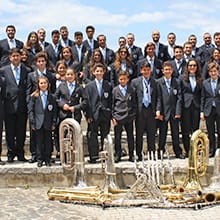
Anselmo Baptista de Freitas Serrão (Jr.)
(Câmara de Lobos, 06/09/1846) - (Estreito de Câmara de Lobos, 08/06/1922)
Abstract:
[Câmara de Lobos, Madeira 06/09/1846 – Estreito de Câmara de Lobos, Madeira 08/06/1922]
Anselmo Baptista de Freitas Serrão Júnior was one of the most dynamic Madeiran musicians in the second half of the 19th century. Composer, organist, maestro, violinist, bandolinist and active participant in philharmonic bands, in which he played wind instruments.
Biography:
Natural of Câmara de Lobos, where he was born in 1846, in the Sítio de Jesus Maria Jose was known just by Anselmo Serrão. His musical training was achieved through his participation in the harmonies of Madeira during the second half of the nineteenth century.
Anselmo Serrão’s work incorporates several pieces written for harmony orchestra, including the Hino da Filarmónica, adopted by the Banda Municipal de Câmara de Lobos; Último Adeus, a funeral musical composition; and musical works that he has composed and arranged for an orchestra, including many European dances, such as the Waltz waltzes, dated 1868; the manuscript Proprio Filio Suo, motet for bass solo, composed in March of 1870; and gallops, with the title L’Enfer, 1876.
Anselmo Serrão was regent of the Filarmónica dos Artistas Funchalenses between 1887 and 1892; integrated the Espoir Theater Orchestra, directed by Francisco de Villa y Dalmau and in 1893 played viola in Madeira’s Characteristic Orchestra, conducted by Agostinho Martins.
Between the performances mentioned, the Diário de Notícias of Madeira reported on April 30, 1891 a show promoted by the troupe Vomique Musical in the Theater D. Maria Pia, which counted with the participation of several artists of the time, among which Anselmo Serrão, Augusto José Migueis and Nuno Graceliano Lino. Composers and regents recognized in Madeira.
In this event Anselmo Serrão was distinguished like “a lesson of music with accompaniment of the troupe [Comique Musical]”, refers the Diário de Notícias de Madeira.
The Diário de Notícias has also published other performances of Anselmo Serrão while Regent of harmonies, special highlighting for the performance of the Filarmónica dos Artistas Funchalenses, June 1888, in the Rua da Praia, Funchal.
Despite his active dedication to secular music, his best-known musical works were written for the Church.
Among the religious groups to which he has been connected stands out the Church Orchestra of Filarmónica Recreio dos Lavradores, whose direction he made in 1917; and the Grupo Musical do Estreito, founded by Anselmo Serrão in 1920, to act in religious festivals and several choirs.
Anselmo Serrão died in 1922 in Madeira, after 60 years of great intervention in the island sacred and profane musical culture.
According to the teacher and researcher João Arnaldo Rufino da Silva, the music of Anselmo Serrão maintained a great influence in the musical world for almost a century between 1870 and 1960. In the 1960s the compositions of Anselmo Serrão were still played, highlighting for Domine non sumdignus, the best-known work, also sung today.
Authors:
Esteireiro, Paulo (2008). “Anselmo Serrão”. In 50 Histórias de Músicos na Madeira. Funchal: Associação de Amigos do Gabinete Coordenador de Educação Artística, p. 20.
Update:
Ventura, Ana (2011). “SERRÃO, Serrão”. In Dicionário Online de Músicos na Madeira. Funchal: Divisão de Investigação e Documentação, Gabinete Coordenador de Educação Artística. Funchal: atualizado em 22/06/2011.
Music:
Último Adeus; Waltz; Proprio Filio Suo; L’Enfer; Domine Non Sumdignus.
Bibliography:
Diário de Notícias (1876 – ). “Coleção de Jornais”. In Biblioteca do Arquivo Regional da Madeira [s.n. recurso digitalizado]. Funchal: publicado em 28-04-1889, Nº 3: 689, p. 2.
Esteireiro, P. (2008). “Anselmo Serrão”. In 50 Histórias de Músicos na Madeira. Funchal: Associação de Amigos do Gabinete Coordenador de Educação Artística, p. 20.
Freitas, M. P. (2007). Revista de Temas Culturais do Concelho de Câmara de Lobos. Câmara de Lobos: Revista Girão (1ºSemestre de 2007), Vol. II, Nº 4.






